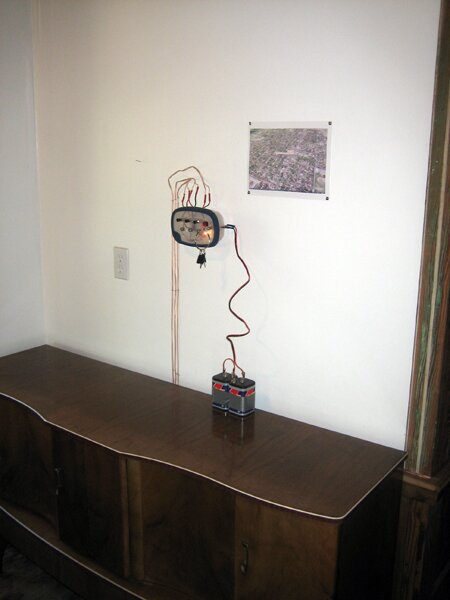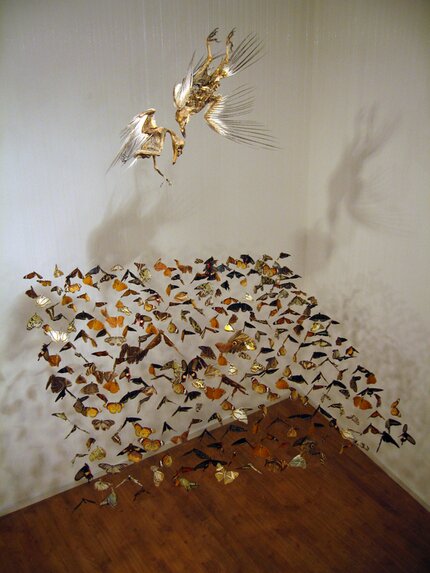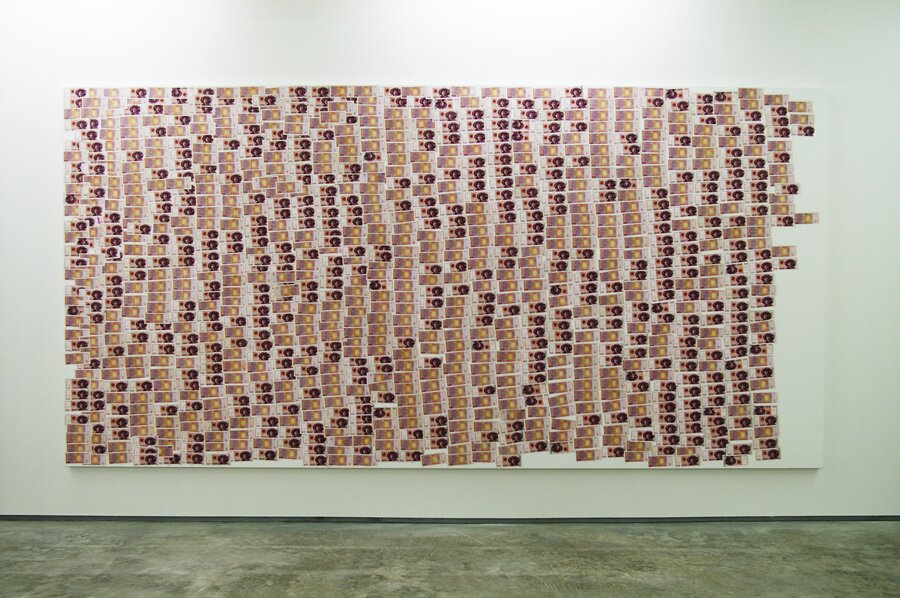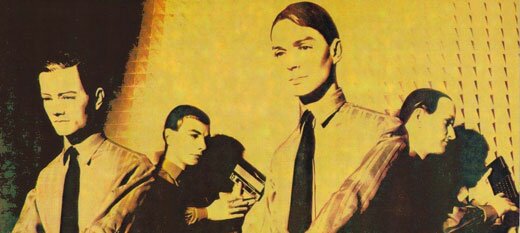March 2007
Monthly Archive
Monthly Archive
Posted by michelle on 11 Mar 2007 | Tagged as: sound art, video/film
This illuminating bit of adroit video editing inhabited the SFMOMA a few years ago, thought it would be a delightful Sunday morning, musical message…Enjoy.
Posted by michelle on 09 Mar 2007 | Tagged as: responses/reviews, sound art

Austin artist Kurt Mueller blasted through the Biennial chatter with a multiple in situ sound and rocket science sculpture installation at Okay Mountain, Site 1808 and the rooftop of Chimaymay’s Art Palace. The innovative sound art sculpture traverses the tender ground between Israeli and Palestinian tensions. The tone that acts as a caveat for incoming rocket fire eerily blares from stoic and orderly speakers perched in the middle of Site 1808. I’m still trying to upload the sound, but in the meantime you can try to listen to it and read more about the popularity of bleak ringtones here.

Here’s one of the control centers…Look but don’t touch that button…

Posted by ben on 07 Mar 2007 | Tagged as: poetry, r.i.p.
 I’m a little slow on the uptake here, but Fluxus poet, performer, and artist Emmett Williams passed away on February 14. He was an important innovator in the areas of concrete poetry, visual poetry, text-sound, permutational poetry, text art, etc. He collaborated with people like Claes Oldenburg, Robert Filliou, Deiter Roth, La Monte Young, and others. Interesting that he died on Valentine’s day, considering two of his more important works are A Valentine for Noël and Sweethearts, an erotic concrete poem cycle which is a “full-scale, permutational masterwork of the concrete movement” (according to the editors of Poems for the Millennium). Most of his books are out of print and fairly rare, but as usual, UBUWEB comes to the rescue.
I’m a little slow on the uptake here, but Fluxus poet, performer, and artist Emmett Williams passed away on February 14. He was an important innovator in the areas of concrete poetry, visual poetry, text-sound, permutational poetry, text art, etc. He collaborated with people like Claes Oldenburg, Robert Filliou, Deiter Roth, La Monte Young, and others. Interesting that he died on Valentine’s day, considering two of his more important works are A Valentine for Noël and Sweethearts, an erotic concrete poem cycle which is a “full-scale, permutational masterwork of the concrete movement” (according to the editors of Poems for the Millennium). Most of his books are out of print and fairly rare, but as usual, UBUWEB comes to the rescue.
Posted by michelle on 05 Mar 2007 | Tagged as: announcements, opportunities

Saatchi takes its new Stuart online art gallery into a High Noon showdown. Here’s your chance to be a critic with a simple 10 star system. Want to get some feedback on your latest work? Set up an account. Log in and start clicking for the best and worst of the Saatchi gang. The Stuart website is similar to a MySpace networking site and I’ve found it helpful to look for new artists or artists in another country/city whenever I’m traveling. Absolutely vital when you’re trying to find out if a residency in Finland is worth the jet lag. There are some simple rules for posting artwork and rating other artists. Claire Morgan’s Making a Killing [pictured above] is one of 3,000 artworks competing in the Showdown. The lucky winner will receive 1,000 euros and the privilege of showing their work in sparkling new Saatchi Gallery. Another contestant, Turkish pixie Ciseren Korkut, offers a nice snapshot of Cappadocia. Memnun oldum. 
Posted by justin on 04 Mar 2007 | Tagged as: sneak peeks, upcoming events
Hi. Let me introduce myself. My name is Justin Parr. I’m frequently seen out and about holding fistfuls of postcards for various art openings. Often these postcards are promoting other folk in my gallery at 1906 s. flores (FL!GHT), but this last month I’ve been dispensing matte invites to my own show (invisible houses.) at the erstwhile “I2I Gallery” (renamed VTRUE Artspace), opening this next Friday at 2110 McCullough in San Antonio TX. So, if your looking for a good time this coming Friday, it might be good to stop on by. Please gaze longingly into the sunset below.
Posted by michelle on 03 Mar 2007 | Tagged as: responses/reviews

Gary Sweeney continues to make colorful and gradually more complicated works of art, whether he’s using plastic cups or sizzling neon signs. His new work seems to be shedding the humorous exoskeleton to reveal much more stoic and poignant subjects. For the Texas Biennial, he made two gigantic fence pieces depicting the pixelated profiles of these American icons. [Currently on view at Site 1808 in Austin.] If you’re in A-town for the South by Southwest conflagration, then drive by the outdoor exhibition before it’s all just another page in history.
Posted by ben on 03 Mar 2007 | Tagged as: responses/reviews
Over at Modern Art Notes, Tyler Green interviews Olga Viso (Part 1 and Part 2), raising some interesting questions about the preservation of art. The question has become more challenging as more and more artists create work that is inextricably tied to a specific location or, even worse, that is intentionally ephemeral. How do the museums and archives weigh respect for the (ephemeral, site specific) nature of the art against the cultural value of bringing it to a wider audience? One question that comes to my mind as I read the interview is whether certain kinds of art should not be documented at all. Of course this is an idea most curators and critics will be reluctant to entertain, but perhaps there is value in letting an artistic statement wither and fade as the context that birthed it recedes into the past.
Posted by michelle on 01 Mar 2007 | Tagged as: responses/reviews

A couple of criminals in the plucky country of Norway decided to cut up a work of art made entirely of 100,000 Norwegian Kroner [the equivalent of $16,300]. Yesterday, some sticky fingers swiped a couple of Picasso paintings to the tune of $66 million American dollars. Oof. This hot artistic crime wave suggests a short contemplation of the ambit of value in the upper echelon of the art world. Norwegian artist Jan Christensen knew the gamble he was taking when he constructed this tempting piece of work. Relative Value sold at its face value prior to the theft from Gallery MGM in Oslo. I conducted a short online interview with Jan a few days ago. Let’s see what he had to say about high crimes, consumerism and counterfeit intelligence:
EMV: How long was the artwork installed before it was stolen?
JC: The exhibition opened January 27, so it was installed for a little less than a month.
EMV: The BBC said the culprits “cut” the notes off the canvas, how did you attach them together?
JC: The notes were glued onto the canvas with wallpaper glue, which is water-based glue. The stretchers measure 2 x 4 meters so the whole thing would have been impossible to sneak out into the street and even put in an average truck. The canvas was stitched onto the stretchers leaving the burglars with no time to properly unstitch it from the time of the alarm going off. Within 12 minutes the security service arrived and the burglars were already gone. The only way for them to move this fast would be to cut the canvas along the stretcher.
EMV: For the general public, it seems that art prices can be arbitrary. Did you consider using counterfeit notes? How does this piece fit in with your previous artwork?
Posted by ben on 01 Mar 2007 | Tagged as: essays, music

Following up on the Kraftwerk video I posted last week, I thought y’all might like a little background on what these guys were trying to accomplish. I find it interesting that critical writing about music most often emphasizes the formal and emotional aspects of the work, and generally disregards the philosophical implications. Visual art criticism, on the other hand, often focuses on the conceptual aspects of the work to the point that the discussion revolves around ideas that are tangential to the actual pieces. In any case, here’s an excerpt from a Lester Bangs interview with Kraftwerk from 1975 which gets to the heart of the Kraftwerk philosophy (read the whole thing on the Creem site):
They referred to their studio as their “laboratory,” and I wondered aloud if they didn’t encounter certain dangers in their experiments. What’s to stop the machines, I asked, from eventually taking over, or at least putting them out of work? “It’s like a car,” explained Florian. “You have the control, but it’s your decision how much you want to control it. If you let the wheel go, the car will drive somewhere, maybe off the road. We have done electronic accidents. And it is also possible to damage your mind. But this is the risk one takes. We have power. It just depends on what you do with it.”
I wondered if they could see some ramifications for what they could do with it. “Yes,” said Ralf, “it’s our music, we are manipulating the audience. That’s what it’s all about. When you play electronic music, you have the control of the imagination of the people in the room, and it can get to an extent where it’s almost physical.”
I mentioned the theories of William Burroughs, who says that you can start a riot with two tape recorders, and asked them if they could create a sound which would cause a riot, wreck the hall, would they like to do it? “I agree with Burroughs,” said Ralf. “We would not like to do that, but we are aware of it.”
“It would be very dangerous,” cautioned Florian. “It could be like a boomerang.”
“It would be great publicity,” I nudged.
“It could be the end,” said Florian, calm, unblinking. “A person doing experimental music must be responsible for the results of the experiments. They could be very dangerous emotionally.”
I told them that I considered their music rather anti-emotional, and Florian quietly and patiently explained that “‘emotion’ is a strange word. There is a cold emotion and other emotion, both equally valid. It’s not body emotion, it’s mental emotion. We like to ignore the audience while we play, and take all our concentration into the music. We are very much interested in origin of music, the source of music. The pure sound is something we would very much like to achieve.”